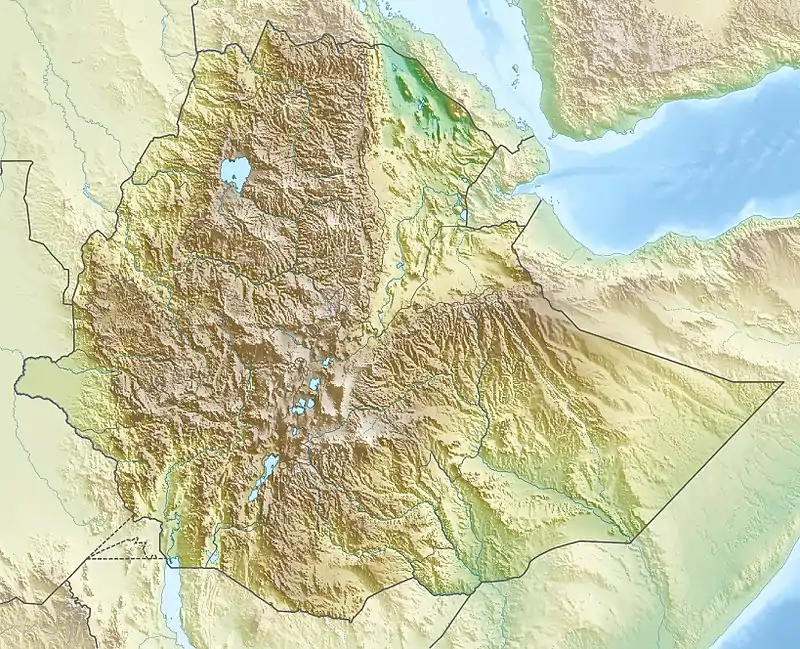Shungura Formation
The Shungura Formation is a stratigraphic formation located in the Omo river basin in Ethiopia. It dates to the Late Pliocene to Early Pleistocene. Oldowan tools have been found in the formation, suggesting early use of stone tools by hominins. Among many others, fossils of Panthera were found in Member G of the formation.[1]
| Shungura Formation Stratigraphic range: Piacenzian-Gelasian | |
|---|---|
| Type | Geological formation |
| Unit of | Omo Group |
| Underlies | Kalam Formation |
| Overlies | Mursi Formation |
| Lithology | |
| Primary | Sandstone, siltstone |
| Other | Claystone, tuff |
| Location | |
| Coordinates | 5.1°N 36.0°E |
| Approximate paleocoordinates | 5.8°N 36.1°E |
| Country | |
| Extent | Omo Subbasin Turkana Basin |
 Shungura Formation (Ethiopia) | |
Description
The formation comprises sandstones, siltstones, claystones and tuff, deposited in a fluvial to deltaic lacustrine environment.
Fossil content
Among many others, the following fossils have been reported from the formation:[2][3][4][5][6]
- Acomys sp.
- Aepyceros shungurae
- Aethomys deheinzelini
- Ancylotherium
- Antidorcas recki
- Arvicanthis sp.
- Australopithecus boisei
- Camelops grattardi
- Camelus sp.
- Ceratotherium simum
- Clarias sp.
- Crocidura aithiops
- Diceros bicornis
- Equus oldowayensis
- Eurygnathohippus libycum
- Euthecodon
- Gazella praethomsoni
- Gerbillus sp.
- Gymnarchus sp.
- Helogale hirtula
- Heterocephalus atikoi
- Hexaprotodon protoamphibius, H. shungurensis
- Hipparion sitifense
- Hippopotamus protoamphibius
- Hipposideros kaumbului
- Homotherium Sp.
- Jaculus orientalis
- Kobus ancystrocera, K. ellipsiprymnus, K. oricornis, K. sigmoidalis
- Kolpochoerus limnetes
- Lepus capensis
- Loxodonta adaurora, L. exoptata
- Mastomys minor
- Menelikia lyrocera
- Metridiochoerus jacksoni, M. modestus
- Notochoerus euilus, N. scotti
- Nyanzachoerus kanamensis
- Palaeoloxodon recki
- Paracolobus mutiwa
- Paraxerus ochraceus
- Pelomys sp.
- Pelorovis sp.
- Polypterus sp.
- Redunca sp.
- Saidomys sp.
- Syncerus cf. acoelotus
- Synodontis sp.
- Taphozous abitus
- Thallomys quadrilobatus
- Theropithecus brumpti, T. oswaldi
- Tragelaphus gaudryi, T. nakuae
- Tatera sp.
- Xerus sp.
See also
References
- Sabol, 2011, p.230
- ETE Locality 807, Omo - member G at Fossilworks.org
- ETE Locality 860, Omo - member C at Fossilworks.org
- ETE Locality 486, Omo - O.75 at Fossilworks.org
- ETE Locality 452, Omo - O.81, P.928 at Fossilworks.org
- ETE Locality 363, Omo - L.28 at Fossilworks.org
Bibliography
- Sabol, Martin. 2011. Masters of the lost world: a hypothetical look at the temporal and spatial distribution of lion-like felids. Quaternaire 4. 229–236. Accessed 2018-09-02.
Further reading
- L. Bobe and M. Mabela. 1997. Incidence of four gastrointestinal parasite worms in group of cricetomas,Lukaya-Democratic Republic of Congo. Tropicultura 15(3):132-135
- C. S. Churcher and D. A. Hooijer. 1980. The Olduvai Zebra (Equus oldowayensis) from the later Omo beds, Ethiopia. Zoologische Mededelingen 55(22):265-280
- Y. Coppens and F. C. Howell. 1985. Les Faunes Plio-Pleistocenes de las Basse Vallee de l'Omo (Ethiopie), Tome 1: Perissodactyls, Artiodactyls (Bovidae). Cahiers de Paleontologie, Editions du CNRS, Paris
- G. Eck. 1977. Diversity and frequency distributions of Omo Group Cercopithecidae. Journal of Human Evolution 6:55-63
- C. S. Feibel, F.H. Brown, and I. McDougall. 1989. Stratigraphic Context of Fossil hominids from the Omo Group Deposits: Northern Turkana Basin, Kenya and Ethiopia. American Journal of Physical Anthropology 78:595-622
- J. de Heinzelin. 1983. The Omo Group: Archives of the International Omo Research Expedition. Musee Royal de l'Afrique Centrale, Annales Series 8, Tervuren, Belgique 85
- F. C. Howell and Y. Coppens. 1973. Inventory of remains of Hominidae from Pliocene and Pleistocene formations of the lower Omo Basin, Ethiopia (1967-1972). American Journal of Physical Anthropology 40:1-16
- M. G. Leakey. 1982. Extinct large Colobines from the Plio-Pleistocene of Africa. American Journal of Physical Anthropology 58:153-172
- 2015 - Thomas W. Plummer, Joseph V. Ferraro, Julien Louys, Fritz Hertel, Zeresenay Alemseged, René Bobe, L. C. Bishop - Bovid ecomorphology and hominin paleoenvironments of the Shungura Formation, lower Omo River Valley, Ethiopia
- 1979 - Robert J. Rogers & Francis H. Brown - Authigenic mitridatite from the Shungura Formation, southwestern Ethiopia
- G. Suwa, T. D. White, and F. Clark Howell. 1996. Mandibular postcanine dentition from the Shungura Formation, Ethiopia: Crown morphology, taxonomic allocations and Plio-Pleistocene Hominid Evolution. American Journal of Physical Anthropology 101:247-282
- Vickers-Rich, Patricia & Rich, Thomas Hewett (1993); Wildlife of Gondwana. Reed. ISBN 0-7301-0315-3
- H. B. Wesselman. 1984. The Omo Micromammals: Systematics and Paleoecology of Early Man Sites from Ethiopia. Contributions to Vertebrate Evolution 17
This article is issued from Wikipedia. The text is licensed under Creative Commons - Attribution - Sharealike. Additional terms may apply for the media files.
